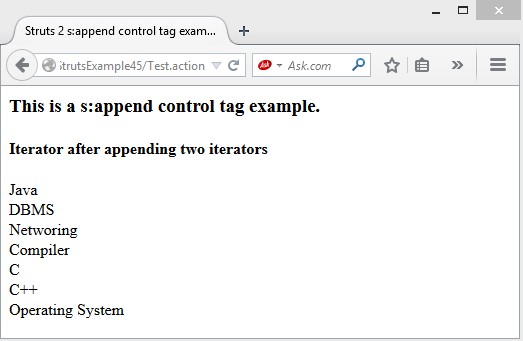s:append:
The s:append control tag is used to append the two or more iterator values into a single iterator value. It uses s:param tag to take the iterator values as parameters.
Syntax:
<s:append var="varName"> <s:param value="%{iterator1}" /> <s:param value="%{iterator2}" /> </s:append> |
Note: First all elements of first iterator will be iterated, then all elements of second iterator and so on.
Example:
index.jsp
<!DOCTYPE HTML PUBLIC "-//W3C//DTD HTML 4.01 Transitional//EN"> <html> <head> <title>Struts 2 s:append control tag example</title> <META HTTP-EQUIV="Refresh" CONTENT="0;URL=Test.action"> </head> <body> </body> </html> |
web.xml
<?xml version="1.0" encoding="UTF-8"?> <web-app version="2.5" xmlns="http://java.sun.com/xml/ns/javaee" xmlns:xsi="http://www.w3.org/2001/XMLSchema-instance" xsi:schemaLocation="http://java.sun.com/xml/ns/javaee http://java.sun.com/xml/ns/javaee/web-app_2_5.xsd"> <filter> <filter-name>struts2</filter-name> <filter-class> org.apache.struts2.dispatcher.ng. filter.StrutsPrepareAndExecuteFilter </filter-class> </filter> <filter-mapping> <filter-name>struts2</filter-name> <url-pattern>/*</url-pattern> </filter-mapping> <welcome-file-list> <welcome-file>index.jsp</welcome-file> </welcome-file-list> </web-app> |
struts.xml
<!DOCTYPE struts PUBLIC "-//Apache Software Foundation//DTD Struts Configuration 2.0//EN" "http://struts.apache.org/dtds/struts-2.0.dtd"> <struts> <package name="default" extends="struts-default"> <action name="Test" class="com.w3schools.action.Test"> <result name="success">/test.jsp</result> </action> </package> </struts> |
Test.java
import java.util.ArrayList; import java.util.List; import com.opensymphony.xwork2.ActionSupport; /** * This class is used as an action class. * @author w3schools */ public class Test extends ActionSupport{ //data members private List<String> subjectList1; private List<String> subjectList2; //business logic public String execute(){ subjectList1 = new ArrayList<String>(); subjectList1.add("Java"); subjectList1.add("DBMS"); subjectList1.add("Networing"); subjectList1.add("Compiler"); subjectList2 = new ArrayList<String>(); subjectList2.add("C"); subjectList2.add("C++"); subjectList2.add("Operating System"); return SUCCESS; } //getter setters public List<String> getSubjectList1() { return subjectList1; } public void setSubjectList1(List<String> subjectList1) { this.subjectList1 = subjectList1; } public List<String> getSubjectList2() { return subjectList2; } public void setSubjectList2(List<String> subjectList2) { this.subjectList2 = subjectList2; } } |
test.jsp
<%@ taglib uri="/struts-tags" prefix="s"%> <html> <head> <title>Struts 2 s:append control tag example</title> </head> <body> <h3>This is a s:append control tag example.</h3> <s:append var="subjectList"> <s:param value="%{subjectList1}" /> <s:param value="%{subjectList2}" /> </s:append> <h4>Iterator after appending two iterators</h4> <s:iterator value="subjectList"> <s:property/><br/> </s:iterator> </body> </html> |
Output:

Download this example.
Next Topic: Struts 2 s:generator control tag with example.
Previous Topic: Struts 2 merge control tag with example.